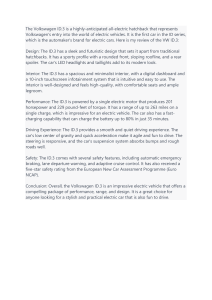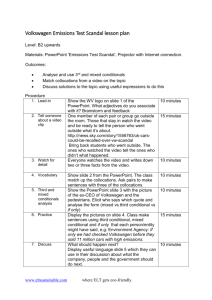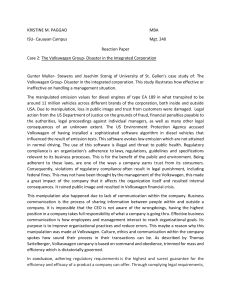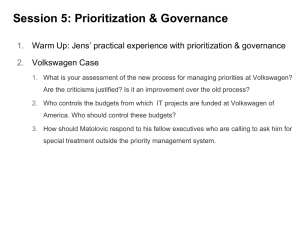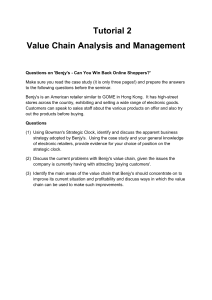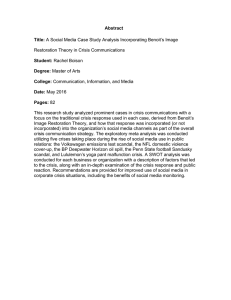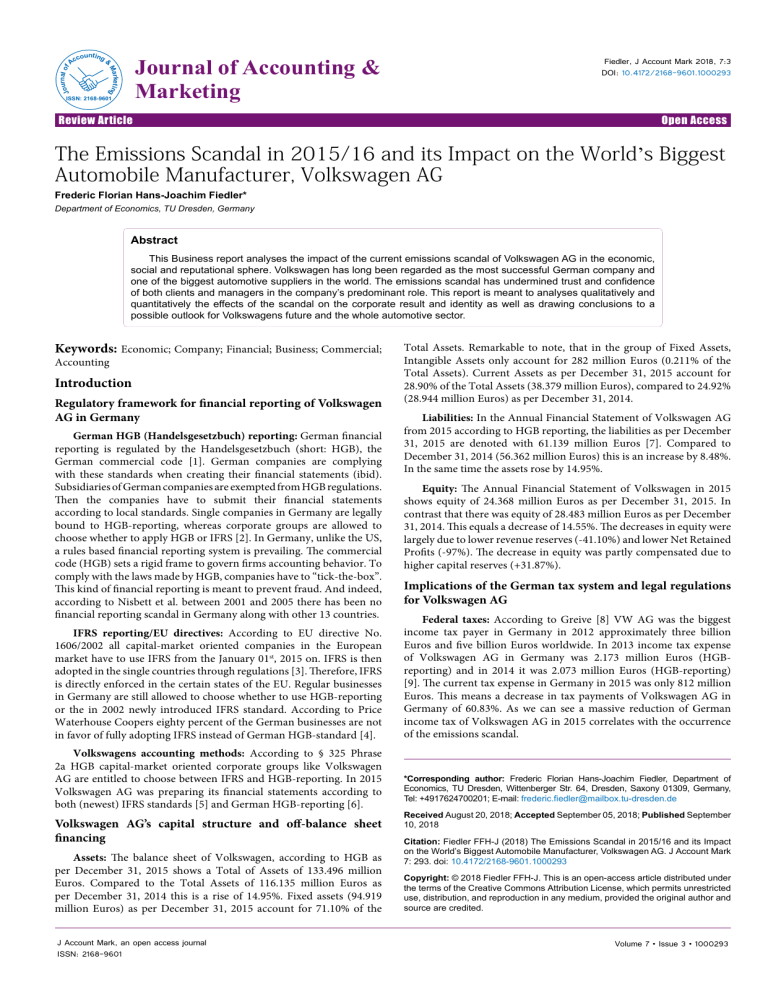
Journal of Accounting & Marketing rketing Ma urnal of Jo & counting Ac ISSN: 2168-9601 Fiedler, J Account Mark 2018, 7:3 DOI: 10.4172/2168-9601.1000293 Review Article Open Access The Emissions Scandal in 2015/16 and its Impact on the World’s Biggest Automobile Manufacturer, Volkswagen AG Frederic Florian Hans-Joachim Fiedler* Department of Economics, TU Dresden, Germany Abstract This Business report analyses the impact of the current emissions scandal of Volkswagen AG in the economic, social and reputational sphere. Volkswagen has long been regarded as the most successful German company and one of the biggest automotive suppliers in the world. The emissions scandal has undermined trust and confidence of both clients and managers in the company’s predominant role. This report is meant to analyses qualitatively and quantitatively the effects of the scandal on the corporate result and identity as well as drawing conclusions to a possible outlook for Volkswagens future and the whole automotive sector. Keywords: Economic; Company; Financial; Business; Commercial; Accounting Introduction Regulatory framework for financial reporting of Volkswagen AG in Germany German HGB (Handelsgesetzbuch) reporting: German financial reporting is regulated by the Handelsgesetzbuch (short: HGB), the German commercial code [1]. German companies are complying with these standards when creating their financial statements (ibid). Subsidiaries of German companies are exempted from HGB regulations. Then the companies have to submit their financial statements according to local standards. Single companies in Germany are legally bound to HGB-reporting, whereas corporate groups are allowed to choose whether to apply HGB or IFRS [2]. In Germany, unlike the US, a rules based financial reporting system is prevailing. The commercial code (HGB) sets a rigid frame to govern firms accounting behavior. To comply with the laws made by HGB, companies have to “tick-the-box”. This kind of financial reporting is meant to prevent fraud. And indeed, according to Nisbett et al. between 2001 and 2005 there has been no financial reporting scandal in Germany along with other 13 countries. IFRS reporting/EU directives: According to EU directive No. 1606/2002 all capital-market oriented companies in the European market have to use IFRS from the January 01st, 2015 on. IFRS is then adopted in the single countries through regulations [3]. Therefore, IFRS is directly enforced in the certain states of the EU. Regular businesses in Germany are still allowed to choose whether to use HGB-reporting or the in 2002 newly introduced IFRS standard. According to Price Waterhouse Coopers eighty percent of the German businesses are not in favor of fully adopting IFRS instead of German HGB-standard [4]. Volkswagens accounting methods: According to § 325 Phrase 2a HGB capital-market oriented corporate groups like Volkswagen AG are entitled to choose between IFRS and HGB-reporting. In 2015 Volkswagen AG was preparing its financial statements according to both (newest) IFRS standards [5] and German HGB-reporting [6]. Volkswagen AG’s capital structure and off-balance sheet financing Assets: The balance sheet of Volkswagen, according to HGB as per December 31, 2015 shows a Total of Assets of 133.496 million Euros. Compared to the Total Assets of 116.135 million Euros as per December 31, 2014 this is a rise of 14.95%. Fixed assets (94.919 million Euros) as per December 31, 2015 account for 71.10% of the J Account Mark, an open access journal ISSN: 2168-9601 Total Assets. Remarkable to note, that in the group of Fixed Assets, Intangible Assets only account for 282 million Euros (0.211% of the Total Assets). Current Assets as per December 31, 2015 account for 28.90% of the Total Assets (38.379 million Euros), compared to 24.92% (28.944 million Euros) as per December 31, 2014. Liabilities: In the Annual Financial Statement of Volkswagen AG from 2015 according to HGB reporting, the liabilities as per December 31, 2015 are denoted with 61.139 million Euros [7]. Compared to December 31, 2014 (56.362 million Euros) this is an increase by 8.48%. In the same time the assets rose by 14.95%. Equity: The Annual Financial Statement of Volkswagen in 2015 shows equity of 24.368 million Euros as per December 31, 2015. In contrast that there was equity of 28.483 million Euros as per December 31, 2014. This equals a decrease of 14.55%. The decreases in equity were largely due to lower revenue reserves (-41.10%) and lower Net Retained Profits (-97%). The decrease in equity was partly compensated due to higher capital reserves (+31.87%). Implications of the German tax system and legal regulations for Volkswagen AG Federal taxes: According to Greive [8] VW AG was the biggest income tax payer in Germany in 2012 approximately three billion Euros and five billion Euros worldwide. In 2013 income tax expense of Volkswagen AG in Germany was 2.173 million Euros (HGBreporting) and in 2014 it was 2.073 million Euros (HGB-reporting) [9]. The current tax expense in Germany in 2015 was only 812 million Euros. This means a decrease in tax payments of Volkswagen AG in Germany of 60.83%. As we can see a massive reduction of German income tax of Volkswagen AG in 2015 correlates with the occurrence of the emissions scandal. *Corresponding author: Frederic Florian Hans-Joachim Fiedler, Department of Economics, TU Dresden, Wittenberger Str. 64, Dresden, Saxony 01309, Germany, Tel: +4917624700201; E-mail: frederic.fiedler@mailbox.tu-dresden.de Received August 20, 2018; Accepted September 05, 2018; Published September 10, 2018 Citation: Fiedler FFH-J (2018) The Emissions Scandal in 2015/16 and its Impact on the World’s Biggest Automobile Manufacturer, Volkswagen AG. J Account Mark 7: 293. doi: 10.4172/2168-9601.1000293 Copyright: © 2018 Fiedler FFH-J. This is an open-access article distributed under the terms of the Creative Commons Attribution License, which permits unrestricted use, distribution, and reproduction in any medium, provided the original author and source are credited. Volume 7 • Issue 3 • 1000293 Citation: Fiedler FFH-J (2018) The Emissions Scandal in 2015/16 and its Impact on the World’s Biggest Automobile Manufacturer, Volkswagen AG. J Account Mark 7: 293. doi: 10.4172/2168-9601.1000293 Page 2 of 5 State taxes: There is a strong influence of Volkswagen AG’s corporate results and the municipal tax income of the production locations like Wolfsburg, Zwickau and Leipzig. For the cities like Wolfsburg and Zwickau the Volkswagen emissions scandal caused a great decline in commercial tax (‘Gerwerbesteuer’) [10]. Exact amounts are not published yet, but the municipality of Wolfsburg has already set a spending freeze for their finances [11]. Vehicle tax evasion because of the emissions scandal: According to Sueddeutsche Zeitung [12] eight hundred thousand diesel Vehicles worldwide and two hundred thousand diesel Vehicles in Germany are in danger of additional tax payments. Volkswagen has recently announced to take over these additional costs and has inquired the German Vehicle Tax Authorities to directly bill Volkswagen for the additional costs (ibid). These additional costs are not yet considered in the financial statements of the recent years and carry further cost-risks, which are not yet certain to be quantified. Reporting of Intangible Assets and Financial Instruments Measurement principles Intangible Assets: In Volkswagen AG’s annual report [9] it is stated that research costs are recognized when incurring in accordance with IAS 38. Depreciation of intangible assets follows a straight line depreciation method (ibid). Brand names from business combinations, having an indefinite life, are not amortized (ibid). Goodwill, intangible assets with indefinite useful life or those which are not yet used are tested for impairment once a year (ibid). Financial instruments: i. Financial instruments measured at fair value: Net gains and losses from financial assets and liabilities are composed of fair value measurement of gains and losses on derivate, comprising interest gains and losses along with currency transactions [5]. ii. Financial instruments measured at amortized costs: Net gains and losses from loans and receivables are measured with amortized costs, as well as financial liabilities (ibid). Effective interest method of IAS 39 is used (ibid). iii. Financial instruments not related to IFRS 7: The financial instruments not falling in the frame of IFRS 7 are particular investments in association with joint ventures, which are accounted using the equity method [5]. divided by Current Liabilities. The higher the value gets, the better the prospect for a company to fulfill their short-term obligations (ibid) (Table 2) [15]. In Volkswagen’s case the CR is constantly decreasing from 1.03 (2013) to 0.98 (2015). This means a decrease of 4.85%. As the CR sank under 1 in 2015, the Current Assets were then lower than Current Liabilities. This is generally a bad sign, if Current Liabilities are exceeding the Current Assets, which means that a company may not be able to pay off its debts in the short term. Solvency ratio analysis Solvency ratios are indicating if companies are able to pay of their long-term debts and obligations [16]. The viewer is told, whether the cash-flow of a company is sufficient to meet this purpose (ibid). Asset: The Asset Turnover is showing the times of Asset multiplication to reach Revenue. In Volkswagen’s case we can observe a constant decrease in AT. From 2013-2015 the decrease of the AT is 6.45%. Hence, the solvency of VW gets worse (Table 3). Profitability ratios Profitability ratios show, whether a company has adequate operating profits on the company’s asset side. For shareholders this is one of the main questions, because it matters to them to have strong profits of the equity invested. For managers it is important to evaluate the profit for the assets invested. Return on Equity (ROE): ROE shows for investors, whether their capital employed gives a good return. It is an adequate tool to analyses the overall performance of a company (Table 4) [3]. From 2013-2014 the ROE was nearly constant with approximately 11%. In 2015 there was a massive slump of ROE, going to minus 1.67%, which means there is a negative return on Equity. Return on Capital Employed (ROCE): ROCE indicated, if the shareholder’s capital is distributed efficiently. It is Net Operating Profit After Tax / Capital Employed (Table 5) [15]. Date Financial leverage multiplier (FLM) 2013-12 3.70 2014-12 3.90 2015-12 4.34 Table 1: Financial leverage multiplier (FLM). Financial Statement Analysis Date Current ratio (CR) 2013-12 1.03 Liquidity ratio analysis 2014-12 1.00 2015-12 0.98 Liquidity ratios are supposed to indicate if a company is capable of paying back its short term debts and other short-term obligations [13]. The higher this ratio the better is the company’s situation in terms of paying back its short term debts and obligations. Financial Leverage Multiplier (FLM): FLM in this case is 3, 7 times the shareholder’s equity (2013) and constantly rising up to 4, 34 of the shareholder’s capital (2015). The higher the FLM ratio gets, the harder it will be for a company to receive further loans and the higher the risk for a company’s illiquidity. In Volkswagens case FLM rose by 17.3% from 2013-2015 (Table 1). Current Ratio (CR): The Current Ratio is an indicator for a company’s liquidity [14]. It is calculated taken the Current Assets J Account Mark, an open access journal ISSN: 2168-9601 Table 2: Current ratio. Date Asset Turnover 2013-12 0.62 2014-12 0.60 2015-12 0.58 Table 3: Asset Turnover. Date Return on Equity (ROE) 2013-12 11.19 2014-12 11.56 2015-12 -1.67 Table 4: Return on Equity. Volume 7 • Issue 3 • 1000293 Citation: Fiedler FFH-J (2018) The Emissions Scandal in 2015/16 and its Impact on the World’s Biggest Automobile Manufacturer, Volkswagen AG. J Account Mark 7: 293. doi: 10.4172/2168-9601.1000293 Page 3 of 5 In 2013 and 2014 the ROCE was nearly constant with around 6 %. In 2015 there was a massive slump by from 5.84% to -2.48%. Net Profit Margin (NPM): NPM is the part of the revenue, that remains when all operating expenses, interest taxes and preferred stock dividends are deducted from a company’s total revenue (Table 6) [17]. At first, the NPM stays constant with approx 4.5% from 2013-2014. In 2015 it is massively slumping to -9.80%. Dividends The dividends of Volkswagen AG constantly rose from 2013-2015. From 2013-2014 by 0.50 Euros/share and from 2014-2015 even by 0.80 Euros/share. From 2013-2015 the dividend payments rose by 37.14%, even though all significant ratios indicate a strong decrease in revenue and profitability and so forth. According to Shing [18] after a forecasted dividend of 4.80 € /share in 2016 no there will be no dividend payments in 2016 (Table 7). Date Return on capital employed (ROCE) 2013-12 5.65% 2014-12 5.84% 2015- 12 -2.48% Table 5: Return on Capital Employed. Date Net profit margin (NPM) 2013-12 4.58% 2014-12 4.52% 2015-12 -9.80% Table 6: Net profit margin. Date Dividend 2013-12 3.50 Euros 2014-12 4.00 Euros 2015-12 14.80 Euros Table 7: Dividend. Corporate Governance Structure of Volkswagen AG Legal basis for corporate governance in Germany Corporate governance is the regulatory frame for leading and controlling enterprises [19]. This regulatory frame is vastly influenced by lawmakers and company owners. In Germany the foundations of corporate governance are set in the German Corporate Governance Codex. A governmental commission was installed by the German Federal Ministry of Justice in September 2001 to pass that Codex on the 26th February 2002. The Codex repeats several substantial laws for corporate governance and publicity, as well as numerous recommendations for leading and controlling stock listed companies. Legal foundation for corporate Governance in Germany is the German ‘Aktiengesetz’ (stock-law; short: AktG). Impact of the Volkswagen emissions scandal for the notion of the German corporate governance approach compared to the Anglo-Saxon model In the 1990s experts where discussing replacing the Anglo-Saxon corporate governance system by the German and Japanese corporate governance system [20,21]. On the other side authors like Kaplan [22] emphasize the advantage of the American corporate governance system over the German and Japanese one in discouraging successful companies in over-investing. The German emissions scandal, according J Account Mark, an open access journal ISSN: 2168-9601 to the Australian Board of Company Directors [23] has revealed a ‘climate of fear’ in VW’s corporate Governance, also criticizing the construction of German corporate Governance in general. Big eruption to German corporate governance system due to failure at Volkswagen as biggest German company Bainbridge (2016) is convinced that inherent problems in the construction of German corporate Governance significantly contributed to the emissions scandal. The “co- determination” in the consistence of the board itself, which is common in German companies leads to three massive problems (ibid): 1.) Interest conflict of the dual-class stock held by Families Porsche and Piech 2.) Presence of a Government (Lower-Saxony) as a major stockholder 3.) The characteristically German “two-tier” board around the principle of co- determination It may be just to say, that Volkswagens emissions scandal only revealed major flaws of the German corporate governance system, which have been inherent to the German system already. Surely the emissions scandal will lead to various changes with the aim to improve German corporate governance. Exposure to Foreign Currency Exchange Risk Countries with the highest foreign exchange risks Two examples for foreign exchange risks of last year were: 1.) The abandonment of the minimum exchange rate of the Swiss National Bank of 1.20 CHF for 1 Euro on January 15th, 2015. The Swiss Franc subsequently soared by 30 % and Swatch CEO Nick Hayek called this “a tsunami” for the export reliant Swiss economy [24]. 2.) ECB’s announcement to buy an independent asset purchase programme worth 1.1 trillion Euros. The Euros exchange rate to the USD immediately dropped to the lowest value since September 2003 (ibid). As Switzerland is not a major market for VW and a weak Euro is generally positive for Volkswagen these example can just exemplify the explosive force of currency exchange risks. But especially the currently very weak Chinese Yuan can turn out to be a big problem for the German car manufacturer Volkswagen, as it faces a 5 years’ low compared to the USD [25]. In 2015 VW group sold 3.55 million cars in China [26]. China is the most important market for Volkswagen group, still having growth potential, in case the Chinese economy is continuing to roar. Chinese economy and currency is currently are in danger of a recession. Major risks and measures against these risks apart from financial hedging Currency exchange risks are strongly tied to the economic standing of one country. Companies like Volkswagen, strongly reliant on certain markets like China, have to anticipate market events in particular economies. Through diversifying manufacturing facilities in the whole world, paying wages and materials with the local currency as well as selling cars with the local currency implements a money circle softening currency exchange risks to a large extent [27]. Volume 7 • Issue 3 • 1000293 Citation: Fiedler FFH-J (2018) The Emissions Scandal in 2015/16 and its Impact on the World’s Biggest Automobile Manufacturer, Volkswagen AG. J Account Mark 7: 293. doi: 10.4172/2168-9601.1000293 Page 4 of 5 Implications of the Emissions Scandal 2015/16 on Corporate, Finance and Governance Short term or long term public trust problem of Volkswagen? According to Weber [28] the case of Volkswagen AG is not to be compared with the ‘Deepwater Horizon’ case, which led to draconian penalty payments of BP. In this case many Volkswagen drivers feel personally betrayed, buying a defaulted car (ibid). Moreover, many clients are potentially confronted with additional unexpected vehicle tax payments. In the short term the impact for the reputational damage will be less grave, if Volkswagen accomplishes to calm down clients on the one hand with financial compensation and to reconcile investors and authorities as well as the federal states in Germany (as large corporate tax receivers) concerning the collapsing profits on the other. The current challenge can well be called a ridge walk. Changes in corporate culture? Cabras, an IR expert, is convinced, that the emissions scandal has to lead to a change in VW’s corporate culture [28]. The formerly prevailing ‘atmosphere of fear’ leading to pressurized profit generation [29] will change, because management has to realize the external costs of corporate decisions, eventually falling back to the corporate result. Financial effects of the emissions scandal Short term impact: There is much evidence of a grave impact on Volkswagens finances in the short run. 11 million cars are affected by the scandal worldwide and Volkswagen had to set aside 6.7 bn. € to covers cost in 2016 and in the last quarter of 15 Volkswagen had to state its first loss for 15 years (2.5 bn. €) [23]. Long term impact: Definitely the VW’s emissions scandal has undermined trust in the whole automotive industry [30]. Du et al. appeal, that a decisive action now may prevent Volkswagen from major future damage. Economically, the VW scandal can be handled well as for now, but if the reputational damage continues to pull down car sales, it can lead to major problems for the company. Everything relies on the willingness for changes in the corporate identity of Volkswagen to regain trust in both company and cars to be technologically advantageous and clean [31-33]. Scandal management According to Rikken [31] the new VW CEO Michael Müller (former Porsche CEO) has acted too defensively and uncertain. To prevent major long term damages, it is evident, that Volkswagen needs to take more decisive measures to ensure a major regain of trust. Conclusion Volkswagen has experienced massive eruptions in the three spheres: 1.) Public sphere: Public trust in the company has been demolished and Volkswagens corporate identity has shown to be insufficient. 2.) Economic sphere: Economic analysis has shown, that all ratios have worsened in terms of liquidity, solvency and especially profitability (huge decrease). 3.) Corporate sphere: On the corporate sphere Volkswagen’s corporate identity has shown to be insufficient, the principle of fear among the employees does not lead to success and creates external costs which eventually fall back to the company’s results. These costs will hopefully be accounted for in the future. J Account Mark, an open access journal ISSN: 2168-9601 It is quite clear, that in the short-term Volkswagen will manage to compensate losses and fix the faulty emission devices. But it is not clear, regarding the improper scandal management of new Volkswagen CEO Müller, if Volkswagen is really inclined to change its corporate culture, which is dominated (and suppressive) by two owner families Porsche and Piech. In the long run a culture change along with decisive measures to regain employee’s, client’s and public’s trust will be essential to secure Volkswagens dominant role in the automotive sector. References 1. Hoffmann R (2014) Ecovis. 2. Kohs C (2014) Significant accounting differences between HGB and IFRS presented using case studies. Berlin: Hans Boeckler Stiftung. 3. Elliott B, Elliott J (2015) Financial Accounting and Reporting. (17th Edn). Harlow: Pearson. 4. Price Waterhouse Coopers (2009) Bilanzieren nach IFRS, IFRS for SMEs und HGB Die wichtigsten Unterschiede im Überblick. Munich: Price Waterhouse Coopers. 5. Volkswagen AG (2016) Additional Income Statement Disclosures in Accordance with IFRS 7 (Financial Instruments). 6. Volkswagen AG (2016) IFRS Around the World. Jurisdictional Profil: European Union - Bilanz der Volkswagen AG zu, 31. Dezember 2015, Wolfsburg: Volkswagen AG. 7. Volkswagen AG (2016) Balance Sheet .Annual Report 2015. 8. Greive M (2013) Are German corporations in front of the treasury? 9. Volkswagen AG (2016) Annual Report 2015. 10. Blum U, Jänchen I, Lubk C (2015) The relevance of corporate headquarters to fiscal performance. J Eco Policy 6: 395-403. 11. Handelszeitung (2015) Budget Lock in VW City Wolfsburg. 12. Süddeutsche Zeitung (2015) VW promises to take over additional motor vehicle tax. 13. Investopedia (2016) Liqudity Ratios. 14. Accounting Coach (2016) What is the Current Ratio. 15. GuruFocus (2016) Volkswagen AG Current Ratio 1.01. 16. Investopedia (2016) Solvency Ratio. 17. Investing Answers (2016) Net Profit Margin. 18. Shing E (2016) Volkswagen emissions scandal is a boon for the BMW investor. International Business Times. 19. Winter E (2014) Gabler Wirtschaftslexikon. YCharts 2016. Volkswagen (VLKAY). (18th Edn). Springer: Berlin. 20. Roe M (1993) Some differences in corporate structure in Germany, Japan and the United States. Yale Law Journal 102: 1927-2003. 21. Charkham J (1994) Keeping Good Company: A Study of Corporate Governance in Five Countries, Oxford: Clarendon Press. 22. Kaplan SN (1997) Corporate governance and corporate performance: a Comparison of Germany, Japan, and the U.S. J App Corp Finance 9: 86-93. 23. Hotten R (2015) Volkswagen: The scandal explained. BBC News, 10th December. IFRS, 2002. IFRS around the World. Jurisdictional Profile: European Union. 24. Décision Performance Conseil (2016) Hedging foreign exchange risk, a strategic challenge for international companies (1/3). 25. FAZ (2016) China’s yuan should continue to depreciate. 26. German China (2016) Sales of Volkswagen in China fell in 2015. 27. Bork M (2016) Saving costs during the crisis: going abroad also secures your home base. 28. Weber M (2015) How VW can regain investor confidence. W & V. Volume 7 • Issue 3 • 1000293 Citation: Fiedler FFH-J (2018) The Emissions Scandal in 2015/16 and its Impact on the World’s Biggest Automobile Manufacturer, Volkswagen AG. J Account Mark 7: 293. doi: 10.4172/2168-9601.1000293 Page 5 of 5 29. Ewing J, Bowley G (2015) The Engineering of Volkswagen’s Aggressive Ambition. New York Times. 30. Du S, Merill SD (2016) The VW Scandal Continues: Implications for Corporate Social Responsibility. J Account Mark, an open access journal ISSN: 2168-9601 31. Rikken M (2016) What Volkswagen needs to do to regain public trust. 32. Volkswagen AG (2016) 10 Income Tax/Expense. 33. Morningstar (2016) Volkswagen AG ADR VLKAY. Volume 7 • Issue 3 • 1000293
